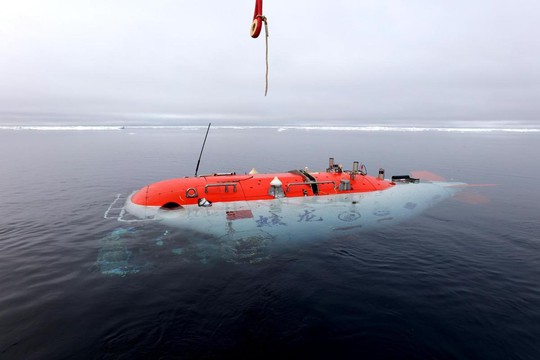Submersible Jiaolong being readied for a dive in the Arctic Ocean.
Photo: Ministry of Natural Resource/Xinhua
China has wrapped up the country’s 15th Arctic scientific expedition with icebreaker Xue Long 2 returning to Shanghai on September 26. This marks the completion of the country’s most expansive Arctic Ocean activity to date.
China’s Ministry of Natural Resources spearheaded this summer’s expedition involving four vessels, including several icebreakers or ice-class ships.
At times the vessels were shadowed and queried by the U.S. Coast Guard as they entered into the Extended Continental Shelf (ECS), where innocent passage is permitted but economic or scientific activity requires permission by the host state.
The expedition included the launch of the submersible Jiaolong carried aboard Shen Hai Yi Hao in early August. This is the first time China has conducted manned deep sea diving in the Arctic Ocean representing a milestone “reflecting the country’s growing capacity to access and explore the deep sea,” according to a Ministry statement.
It is unclear how extensive Jiaolong’s use was in the Arctic or how deep it dove. The submersible previously reached a depth of 3,759 meters in the South China Sea making China only the fifth nation to send a manned craft below 3,500 meters. It is designed for a maximum depth of 7,000 meters.
At the time of Jialong’s dive on August 6 its mothership Shen Hai Yi Hao was operating in the Chukchi Sea around 300 nautical miles to the northwest of Alaska. The U.S. Coast Guard dispatched C-130J Hercules aircraft from Air Station Kodiak several times to monitor the activity. Late in August and into September icebreakers Healy and Storis also shadowed Chinese vesselsk.
China’s Ministry of Natural Resources says that this year’s expedition further enhanced the country’s understanding of the rapidly changing Arctic environment. Xue Long 2 and Jidi carried out extensive marine surveys along the Chukchi Plateau, the Canada Basin and to the north of Russia in the central Arctic Ocean. China’s state-owned news agency Xinhua says the vessels conducted “multidisciplinary investigations” along the sea ice edge and completed three-dimensional observations.
Improved understanding of sea ice changes and accurate forecasting will be key to facilitating commercial operations in the future.
Currently several Chinese commercial vessels are passing through the Arctic, including the first-ever container ship with direct service to Western Europe.
read more in our Telegram-channel https://t.me/The_International_Affairs

 10:15 25.10.2025 •
10:15 25.10.2025 •























